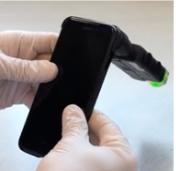A group from the University of Arizona has come up with something that sounds like it belongs in a science fiction movie; an easy, immediate test for norovirus – the bug that causes the "stomach flu" – using a modified smartphone.
Norovirus, which is one of the most infectious pathogens, claims 20 million victims in the US every year, mostly in the winter. One of the many ways that the virus is transmitted is by water and Jeong-Yeol Yoon and colleagues at UA College of Biomedical Engineering came up with a smart method to detect insanely small (10-18 grams) quantity of the virus. Here's how it works (1).
1. Norovirus antibodies in a water solution are chemically attached to fluorescent polystyrene beads. The chemistry used to make conjugated antibody beads is decades old.

2. A cellulose paper microfluidic chip, a commonly used device in biological assays such as pregnancy test kits and blood glucose detection, is wet with potentially contaminated water.

3. The solutions are mixed (left, below). The norovirus particles "find" and bind to the antibodies (green). Virus particles are capable of binding to multiple antibodies, bringing the fluorescent beads within close proximity (left, below). This generates a detectable fluorescent signal.

4. The detector is made by attaching a smartphone to a light microscope. Filters are added to block out non-fluorescent light. The device reads the fluorescent signal generated by the solution. The more norovirus, the greater the signal.

5. The app converts the reading into a readout. The results are difficult to see so I have enlarged them (yellow boxes).

Instead of waiting hours, maybe even days for a lab to run a polymerase chain reaction (used to measure DNA or RNA of specific viruses) the test takes seconds.
Very clever chemistry with a real-world application. And an app.
NOTE:
(1) The images are screenshots taken from a YouTube video made by the American Chemical Society.




